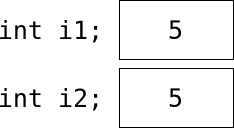Basic Types and Reference Types
We have said before that a variable is a sort of box that can be used to store a value. But there is a difference between what we call “basic” values, such as integers, and more complex values, such as arrays. The basic values are stored in the variables, just as as we can expect, but the complex ones are not. They are stored somewhere else, and the variable only contains a reference to the actual data.
Usually, you don’t need to think about this difference, but there are cases when it is important.
Here is an example to show exactly what the difference means.
We start by defining an integer variable called i1:
int i1;
This variable can now be used to store integer values.
We put the value 5 in i1:
i1 = 5;
If we could look inside the computer, this is what we would see:

A non-reference variable
i1 is a box, which contains the value 5.
We now define another integer variable, called i2,
and copy the value in i1 to i2:
int i2;
i2 = i1;
This is how it looks now:

Two non-reference variables, before the change
As we might have expected,
there is a 5 in i1,
and another 5 in i2.
What happens if we change the value of i2?
i2 = 17;
Well, again as expected,
the value in the variable i2 changes.
The value in i1 of course doesn’t:

Two non-reference variables, after the change
But with complex types, such as arrays,
things are a bit different.
To illustrate this,
we define an array variable, a1:
array(int) a1;
This variable is of the type “array(int)”,
so we can use it to store arrays of integers.
So let’s do just that.
We create an array,
and put that array in a1:
a1 = ({ 19, 3, 5 });
Inside the computer, it now looks like this:

A reference variable
Note that a1 doesn’t actually contain the array,
it just contains a “pointer” or “reference” to the array.
What happens if we try to do the same thing as we did with the integers above, that is, copy the value to a new variable, and then change the value in that new variable?
To show what happens,
we define a new array variable, a2,
and try to copy the array a1 to this new variable:
array(int) a2;
a2 = a1;
This is where things are different.
Remember that the variable a1 doesn’t contain the real array,
but just a reference to it,
and that an expression of the type
a2 = a1;
means “take whatever there is in a1,
make a copy of it, and put that copy it in a2“.
Because of this,
what gets stored in a2 is a copy of the reference,
not of the array:

Two reference variables, before the change
Note that both a1 and a2 now point to the same array.
If we now try to change a2,
for example by changing the last element in a2 from 5 to 17:
a2[2] = 17;
what will change is the array pointed to by the reference in a2:

Two reference variables, after the change
If we don’t think about the fact
that a1 and a2 just contain references,
pointing to the same array,
it would seem as if our change to the variable a2 had,
in some mysterious way,
also changed the contents of the variable a1!
If we want a real copy,
and not just a reference to the same array,
we must create that copy explicitly.
We can use the function copy_value for this:
a2 = copy_value(a1);
This will create a copy of the array,
and store a reference to that copy in a2:

Two reference variables, pointing to different things
Note that copy_value creates a recursive copy,
which means that if the array contains other arrays,
it will create copies of those arrays too,
and so on.
A trick for creating a non-recursive copy of an array
is to add an empty array:
a2 = a1 + ({ });
The result of the expression a1 + ({ })
is a new array that is a copy of a1.
The following data types in Pike are basic types, and are stored in the variables themselves:
intfloatstring
The following data types in Pike are reference types, and what is stored in the variables are just references to the data objects:
arraymappingmultisetprogramobjectfunction
Note that the same difference applies to method calls. When you send data to a method as arguments, and when you return data as the value of the method, what is actually sent is either the values themselves (for the basic types), or references (for the reference types).